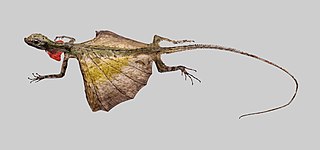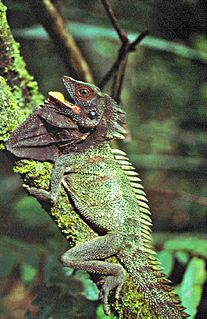
Draco is a genus of agamid lizards that are also known as flying lizards, flying dragons or gliding lizards. These lizards are capable of gliding flight via membranes that may be extended to create wings (patagia), formed by an enlarged set of ribs. They are arboreal insectivores.

Draco volans, also commonly known as the common flying dragon, is a species of lizard in the family Agamidae. The species is endemic to Southeast Asia. Like other members of genus Draco, this species has the ability to glide using winglike lateral extensions of skin called patagia.

Calotes calotes, the common green forest lizard, is an agamid lizard found in the forests of the Western Ghats and the Shevaroy Hills in India, and Sri Lanka.

Monilesaurus ellioti, or Elliot's forest lizard, is a species of arboreal, diurnal, lizard in the family Agamidae, endemic to the Western Ghats, India.

Calotes emma, commonly known as the forest garden lizard or Emma Gray's forest lizard, is a species of lizard in the family Agamidae. The species is endemic to China, South Asia, and Southeast Asia.

Calotes mystaceus, the Indo-Chinese forest lizard or blue crested lizard, is an agamid lizard found in China, South Asia and Southeast Asia.

Draco blanfordii, commonly known as Blanford's flying dragon, Blanford’s flying lizard, or Blanford's gliding lizard, is a species of "flying" lizard in the family Agamidae. The species is endemic to Asia, and is capable of gliding from tree to tree.

Draco dussumieri, also known as the Indian flying lizard, Western Ghats flying lizard, or southern flying lizard, is a species of agamid lizard capable of gliding from tree to tree. It is found principally in the Western Ghats and some other hill forests of Southern India. They are almost completely arboreal, found on trees in forests and adjoining palm plantations where they climb trees to forage for insects and glide to adjoining trees by expanding the patagium, loose skin on the sides of the body which are supported by elongated ribs to act as wings. The skin on the sides of the neck are also extended to the sides using the hyoid bones of the tongue to support them. During the breeding season males maintain small territories which they defend from other males while courting females. Males have a more colourful patagium than females and they prominently extend their yellow dewlaps forward in display. Although living almost their entire lives on the trees, females descend to the ground to lay eggs in soil. This is the species with the westernmost distribution within the genus Draco, the majority of species occurring in Southeast Asia.

Draco maculatus, commonly known as the spotted flying dragon or spotted gliding lizard, is a species of agamid flying lizard endemic to Southeast Asia. It is capable of gliding from tree to tree.

Draco norvillii, also known as Norvill's flying lizard, is species of agamid flying lizard endemic to India. This species is capable of gliding from tree to tree, and has been recorded gliding up to 50 metres (160 ft). It feeds on insects and other small invertebrates.

The peninsular rock agama or South Indian rock agama is a common species of agama found on rocky hills in south India. An allied species, Psammophilus blanfordanus, is found in the Eastern Ghats, but north of the range of this species.

Draco sumatranus, the common gliding lizard, is a species of agamid lizard endemic to Southeast Asia. It has elongated ribs and skin flaps on the sides of its body. When opened, these skin flaps allow it to glide between tree trunks.

Hose's frog is a true frog species with a wide range in Southeast Asia. This species was named after zoologist Charles Hose.

The Draconinae are a subfamily of reptiles in the family Agamidae found in southern Asia and Oceania. Some taxonomists believe these genera belong to the subfamily Agaminae.

Draco mindanensis, commonly known as the Mindanao flying dragon or Mindanao flying lizard, is a lizard species endemic to the Philippines. Characterized by a dull grayish brown body color and a vivid tangerine orange dewlap, this species is one of the largest of the genus Draco. It is diurnal, arboreal, and capable of gliding.

Draco spilonotus, the Sulawesi lined gliding lizard, is a lizard endemic to Sulawesi. The species is known from various localities in forested areas of Sulawesi.

Gonocephalus doriae is a species of arboreal lizard in the family Agamidae. The species is endemic to the island of Borneo.

Lophosaurus dilophus, the crowned forest dragon or Indonesian forest dragon, is a large arboreal agamid lizard found in New Guinea and the Moluccan islands, Indonesia.

Diporiphora nobbi, also known commonly as the nobbi lashtail or the nobbi, is a species of lizard in the family Agamidae. The species is endemic to Australia.
Draco boschmai is a species of lizard in the family Agamidae. The species is endemic to Indonesia.



















